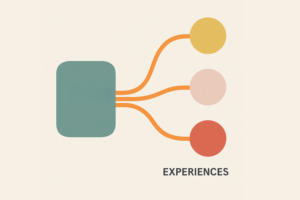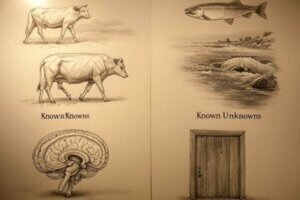
Defining Affective Experiences
How to Define Affective Experiences for Analysis: Striking the Right Level of Detail Cynthia Schuck-Paim & Wladimir Alonso The Welfare Footprint Framework (WFF) is designed to quantify the welfare impact
Wladimir J Alonso, Cynthia Schuck-Paim
Understanding where emotions like love, happiness, pain, and suffering arise in the brain is one of the most profound inquiries we can explore. For centuries, this topic was considered beyond the scope of scientific investigation. Today, however, neuroscience has made significant strides in uncovering the origins of these emotional experiences. This growing knowledge not only deepens our understanding of human nature but also opens doors to practical applications, such as assessing how different species experience pain—critical for measuring animal welfare.
Despite these advances, neuroscience can still seem intimidating, limiting the spread of these insights. But it doesn’t have to be this way. Philosophy, an unexpected but powerful ally, offers a unique lens that complements and clarifies neuroscientific knowledge in exploring these questions. By integrating philosophy with neuroscience, we can make complex ideas more accessible and engaging. In fact, many philosophical dilemmas are rooted in conflicts between different brain systems—age-old debates that have been discussed by thinkers like Aristotle, Kant, Nietzsche, Freud, and Descartes. By revisiting these debates from a neuroscientific perspective, we can make the journey to understanding animal brains and minds, including our own, far more enlightening.
This is where neurophilosophy comes in—a field that bridges neuroscience with philosophical questions about the mind, consciousness, and cognition. Foundational thinkers like Patricia Churchland have shown how integrating these fields can reshape traditional debates about our mental and emotional lives.
One effective way to grasp the complexity of the brain is through its evolutionary development. In simplified terms, the brain can be divided into two systems: the ‘old brain’ and the ‘new brain.’ The ‘old brain’ includes ancient structures responsible for survival functions and basic emotions like fear, hunger, and instincts, governed by areas such as the brainstem and limbic system. The ‘new brain,’ centered in areas such as the neocortex in mammals, is responsible for higher-order cognitive functions like abstract thinking, decision-making, and moral reasoning.
As the brain evolved, these two systems were layered upon one another. Today, they coexist—sometimes harmoniously, but often in conflict. This tension is where many philosophical and ethical dilemmas arise, as our primitive emotional desires frequently clash with our higher-order reasoning, shaped by morality, social norms, and long-term goals. The interaction between these brain systems is central to neuroscience and provides a valuable framework for exploring key philosophical questions about behavior, decision-making, and values.
Traditionally, the study of neuroscience, philosophy, and neurophilosophy has been reserved for scholars or those with specialized backgrounds. With the Neurophilosopher GPT tool, however, we’ve created an interactive platform where anyone can explore these fields —whether you’re a complete beginner or an experienced scholar. By inputting any philosophical author, theory, moral question, or religious idea, you can engage in dynamic discussions that provide detailed neuroscientific analysis through the ‘old brain’ and ‘new brain’ framework.
This tool transforms passive learning into an active, personalized experience. It enables exploring the scientific and philosophical foundations of emotions, consciousness, and thought in a way that makes these subjects accessible and relevant to your everyday life.
The tool draws heavily from a branch of neuroscience called affective neuroscience, which focuses on how emotions (or affective states) arise in the brain. Neuroscientists like Jaak Panksepp, Antonio Damasio, and Mark Solms have argued that emotional experiences are ancient and shared across many species, deeply rooted in the older structures of the brain. In contrast, cognitive neuroscientists often emphasize that conscious emotions are tied to the more advanced neocortical areas found in humans and their closer relatives. For those interested in this ongoing debate, we recommend exploring the detailed discussions between proponents of these perspectives in this paper.
Therefore, while Affective Neurophilosophy would have more accurately described this tool’s focus, we chose to stick with Neurophilosophy to keep it approachable. The term already bridges two complex fields—neuroscience and philosophy—and we didn’t want to make it seem more intimidating. Our goal is to make the tool as inviting and accessible as possible for anyone to explore.
The tool also encourages reflection on contemporary issues with significant ethical implications, such as what brain science can reveal about the capacities for pain and pleasure in other species. If emotional experiences are deeply rooted in ancient brain structures (the ‘old brain’), this raises crucial ethical questions about the extent to which different species, based on their neural architecture, should receive special consideration in terms of suffering prevention and mitigation. These inquiries not only deepen our understanding of our own brains but also guide broader ethical considerations.
Whether you’re interested in exploring classic philosophical ideas or investigating the brain’s role in moral and ethical questions, the Neurophilosopher GPT tool is helpful. You can use the tool to examine how Aristotle’s views on the soul, John Stuart Mill’s distinction between higher and lower pleasures, Jeremy Bentham’s views on animal suffering, Peter Singer’s arguments for animal liberation, Thomas Nagel’s exploration of consciousness, or René Descartes’ perspectives on animal consciousness align with neurophilosophy. The possibilities are vast, providing fresh insights into how our ancient and modern brain systems shape emotions, thoughts and decisions.
We invite you to try the Neurophilosopher GPT tool and discover how the intersection of philosophy and neuroscience can provide a deeper understanding of the capacities for pain and suffering across species, enriching our perspectives on the welfare of animals.

How to Define Affective Experiences for Analysis: Striking the Right Level of Detail Cynthia Schuck-Paim & Wladimir Alonso The Welfare Footprint Framework (WFF) is designed to quantify the welfare impact

Confounding Factors in Welfare Comparisons of Animal Production Systems Wladimir J Alonso, Cynthia Schuck-Paim Controlled experiments—where variables are deliberately manipulated to establish cause-and-effect relationships—are the gold standard for drawing reliable

Borrowing the Knowns and Unknowns Framework to Reveal Blind Spots in Animal Welfare Science Wladimir J Alonso, Cynthia Schuck-Paim There is always a risk of fixating on what we already
